Oral
Acquisition, Reconstruction & Analysis
Monday, 24 April 2017
| Room 315 |
08:15 - 10:15 |
Moderators: Adrienne Campbell-Washburn, Florian Wiesinger |
Slack Channel: #s_acq_recon_analysis
Session Number: O56
08:15
|
0077.
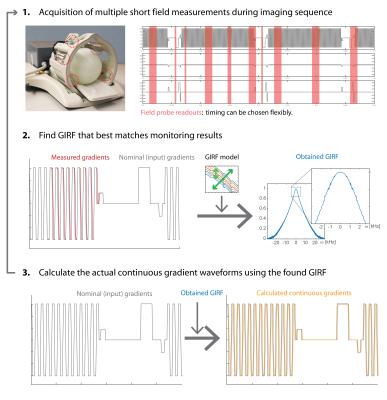 |
Model-based Gradient Impulse Response Harvesting - permission withheld
Bertram Wilm, Benjamin Dietrich, Jonas Reber, Johanna Vannesjo, Alen Mujkanovic, Klaas Pruessmann
Concurrent field monitoring is currently limited to observation times in the order of 100 ms. However, for many purposes it is desirable to determine field dynamics continuously without interruption. To address this need we propose model-based gradient impulse response function (GIRF) harvesting, where GIRFs are continuously updated during the MR experiment. From the harvested GRIFs and the known input to the gradient chains, continuous gradients are obtained. The model-based approach allows to robustly determine continuous gradient fields with high precision. The method is demonstrated by stabilizing a gradient-demanding EPI scan.
|
08:27
 |
0078.
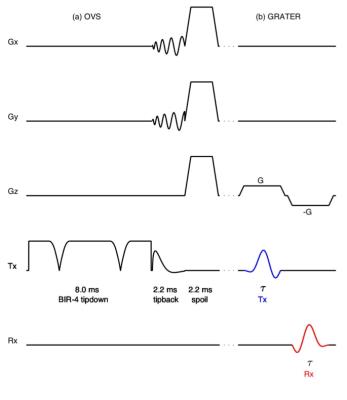 |
Measurement of Small-Tip RF Pulses using Gradient Reversal 
Vanessa Landes, Krishna Nayak
We present a simple pulse sequence for measuring RF pulses in the small-tip regime. In a uniform phantom, results matched closely (<4% difference) with a pick-up RF coil over a broad range of RF pulse parameters, with one outlier (6.1% difference). In non-uniform phantoms and in-vivo, this method combined with an outer-volume suppression (OVS) pre-pulse produced accurate (<3% difference) measurements compared to a pick-up RF coil. Speed and lack of additional hardware could make the proposed method ideal for RF pre-distortion correction.
|
08:39
 |
0079.
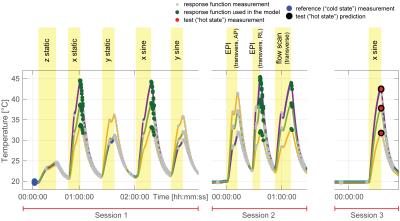 |
Thermal Variation and Temperature-Based Prediction of Gradient Response - permission withheld
Benjamin Dietrich, Jennifer Nussbaum, Bertram Wilm, Jonas Reber, Klaas Pruessmann
Under the assumption that a gradient system is linear and time-invariant (LTI), accurate gradient field waveforms can be predicted by gradient response functions. However, time-invariance can be violated due to heating of system components. Temperature sensors can be used to assess heating of the gradient coils. To assess the predictability of gradient response function based on temperature measurements, the temperature dependence of gradient response functions is analyzed using an NMR probe based field camera and optically connected temperature sensors. From this data a prediction model is generated and tested for its application in image reconstruction.
|
08:51
|
0080.
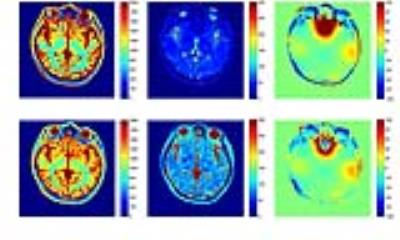 |
Effects of RF pulse profile and within-slice phase dispersion on accuracy of MR fingerprinting with balanced SSFP readout 
Su-Chin Chiu, Te-Ming Lin, Jyh-Miin Lin, Hsiao-Wen Chung, Cheng-Wen Ko, Martin Büchert, Michael Bock
To investigate the effects of within-slice phase dispersion and RF pulse profile on quantitative relaxation mapping using MR fingerprinting with balanced steady-state free precession readout, simulations based on Bloch equations were performed assuming uniform distributions of off-resonance frequency (widths from 0, 1.0, to 2.0 Hz) and imperfect slice profiles of sinc-shaped RF pulses without and with side lobes. Results showed that slight within-slice phase dispersion by 1 to 2 Hz resulted in prominent T2 under-estimations, particularly at large T2 values. Slice profile imperfection led to under-estimations of T1, which became greater as regional off-resonance frequencies increased.
|
09:03
|
0081.
 |
A New Background Field Removal Method Using Region Adaptive Kernel for Human Brain MRI 
Jinsheng Fang, Lijun Bao, Zhong Chen
we propose a new background field removal method by using region adaptive kernel (REAK) based on local energy distribution. Experimental results on simulation data and in vivo human data demonstrated that our method has good performance on suppressing the susceptibility artifacts caused by large susceptibility variations, such as over boundary regions of brain skull, venous vessels and paranasal sinuses. This can facilitate the susceptibility map reconstruction and achieve more accurate QSM approximate to the results of COSMOS, which is helpful for the QSM technique and its application in the clinical medicine.
|
09:15
|
0082.
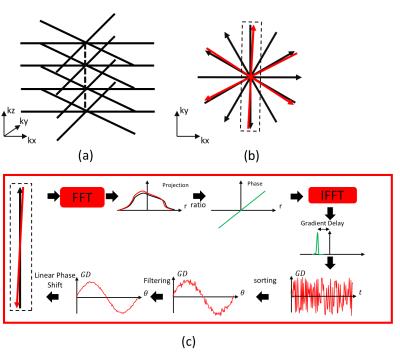 |
Influence of the gradient delay correction on self-navigated motion resolved reconstruction with golden angle stack-of-stars acquisition 
Xucheng Zhu, Mariya Doneva, Peder Larson, Michael Lustig
Gradient delay often leads to misalignment of k-space data, which induces artifacts on reconstructed images. As many self-gated motion correction methods largely depend on central k-space data, misalignment might affect motion state estimation and reconstruction. In order to acquire robust motion states and improve motion resolved reconstruction, we propose a workflow incorporating gradient delay correction, robust motion extraction, and motion resolved reconstruction. We tested our method on in vivo volunteer data, and demonstrate the improvement over a reconstruction that does not account for these delays.
|
09:27
|
0083.
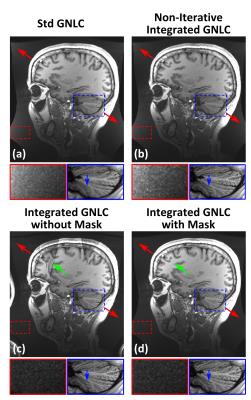 |
Image Reconstruction with Integrated Gradient-Nonlinearity Correction and Constrained Spatial Support 
Shengzhen Tao, Joshua Trzasko, Paul Weavers, Yunhong Shu, John Huston III, Erin Gray, Matt Bernstein
Due to engineering limitations, the spatial-encoding gradient fields in MRI are not exactly linear across the entire field-of-view. If not properly accounted for during reconstruction, the gradient-nonlinearity (GNL) causes image distortion and artificial signal intensity change. Conventionally, the GNL effects are corrected after image reconstruction using image-domain interpolation, followed by intensity correction using the Jacobian-determinant of the distortion field. Images corrected using this method can suffer from noise amplification at regions with strong GNL distortion. Here, we develop a model-based reconstruction method with integrated GNL correction and constrained spatial support, and demonstrate reduced noise amplification effect using this method.
|
09:39
 |
0084.
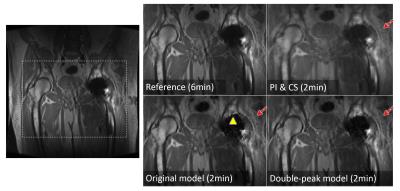 |
Accelerated Imaging of Metallic Implants Using a Double-Peak-Model Constraint 
Xinwei Shi, Evan Levine, Hans Weber, Brian Hargreaves
Multi-Spectral Imaging (MSI) enables MRI near metallic implants, but suffers from prolonged scan times. Model-based reconstruction accelerates MSI by enforcing a signal model along the spectral dimension to reduce the number of unknowns in image reconstruction. The previous signal model assumes that spins in one voxel have the same off-resonance frequency, which tends to fail where the off-resonance field changes rapidly. Here we propose a more flexible MSI signal model that allows multiple frequencies within a voxel, and demonstrate improvements with both simulated and in-vivo data. 3x net additional acceleration above partial-Fourier and parallel-imaging alone (20x in total) was achieved.
|
09:51
 |
0085.
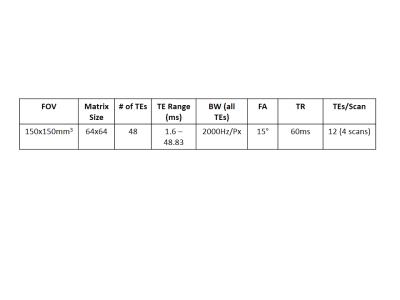 |
Absolute MR Thermometry from Multi-Echo GRE with B0-Correction 
Patrick McDaniel, Mark Spatz, Bastien Guérin, Patricia Grant, Lawrence Wald, Elfar Adalsteinsson
MR thermometry offers the potential to obtain absolute and relative temperature measurements on a voxelwise basis, but is affected by B0 offsets. Since precise (<1°C) temperature measurements are important for simulation validation in phantom experiments, and since realistic phantoms and models have regions of high ΔB0 , there is a need for accurate, B0-robust temperature mapping methods. In this work, we propose such a method using a multi-TE GRE acquisition and validate it in phantom experiments.
|
10:03
|
0086.
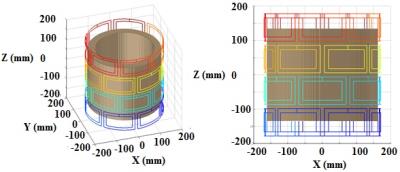 |
Uniform Spatiotemporal Excitation Despite Extreme B0 Inhomogeneity Using Dynamically-Driven Multi-Coil Arrays 
Mohan Jayatilake, Christoph Juchem , Michael Mullen, Lance DelaBarre, Gregor Adriany, Robin de Graaf, Michael Garwood
Developments of new imaging strategies that tolerate extreme B0 inhomogeneity can reduce size and cost of MRI magnets; but with conventional MRI methods, a highly uniform B0 is still required to obtain high quality images. Previously we demonstrated spatiotemporal excitation of spins in the presence of large B0 inhomogeneity when driving a multi-coil array with the dynamic multi-coil technique known as DYNAMITE. In that work, tolerance to B0 inhomogeneity began to degrade when the frequency variation exceeded +/-40 kHz, which is insufficient for imaging with a small magnet. Here we present a technique to substantially extend the range of B0 inhomogeneity tolerance of this approach when using RF pulses based on the principle of offset-independent adiabaticity (OIA).
|
|












